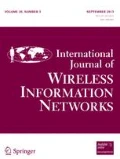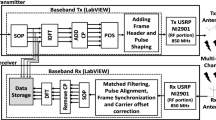Abstract
This paper considers an amplify-and-forward two-way relay system with frequency selective fading channels. The knowledge of channel state information is assumed not available for all nodes. An efficient transmission and signaling scheme is proposed to identify the transmitted symbols and multi-tap channel coefficients using the M-ary phase shift keying transmitted symbols. A blind receiver is derived using the least square error criterion. Simulation results demonstrate that the proposed transmission and signaling scheme outperforms an existing conventional training scheme where pilots are applied to estimate the channel coefficients.




Similar content being viewed by others
References
S. Kim, P. Mitran, and V. Tarokh, Performance bounds for bi-directional coded cooperation protocols, IEEE Transactions on Information Theory, Vol. 54, No. 11, pp. 5235–5241, 2008.
T. Oechtering, and H. Boche, “Optimal tranmsit strategies in multiantenna bidirectional relaying,” in Proc. IEEE Int. Conf. Acoustics, Speech, Signal Processing (ICASSP), Honolulu, HI, Apr. 2007, vol. 3, pp. 145–148.
C. S. Patel, and G. L. Stüber, Channel estimation for amplify and forward relay based cooperative diversity systems, IEEE Transactions on Wireless Communications, Vol. 6, No. 6, pp. 2348–2356, 2007.
G. Farhadi, and N.C. Beaulieu, “A decentralized power allocation scheme for amplify-and-forward multi-hop relaying systems,” in Proc. IEEE Int. Conf. in Commun. (ICC), pp. 1–6. (2010).
N. B. Harum, K. Yuda, and T. Ohtsuki, “PAPR reduction of amplify-and-forward relay OFDM system using subcarrier pairing method,” in IEEE Int.ernational Symposium on Personal Indoor and Mobile Radio Communications (PIMRC), 2013, pp. 2005 – 2010.
L. P. Withers Jr., R. M. Taylor Jr., and D. M. Warme, Echo-MIMO: A two-way channel training method for matched cooperative beamforming, IEEE Transactions on Signal Processing, Vol. 56, No. 9, pp. 4419–4432, 2008.
F. Gao, R. Zhang, and Y. C. Liang, Optimal channel estimation and training design for two-way relay networks, IEEE Transactions on Communications, Vol. 57, No. 10, pp. 3024–3033, 2009.
B. Jiang, F. Gao, X. Gao, and A. Nallanathan, Channel estimation and training design for two-way relay networks with power allocation, IEEE Transactions on Wireless Communications, Vol. 9, No. 6, pp. 2022–2032, 2010.
P. Cheng, L. Gui, Y. Rui, Y.J. Guo, X. Huang, and W. Zhang, Compressed sensing based channel estimation for two-way relay networks, IEEE Wireless Communications Letters, Vol. 1, pp. 201–204, 2012.
X. Xu, J. Wu, S. Ren, X. Luan, and H. Xiang, “Superimposed training and channel estimation for two-way relay networks,” in 16th International Conference on Advanced Communication Technology (ICACT), Pyeongchang, Feb. 2014, pp. 1050 – 1054.
S. Zhang, F. Gao, and C. Pei, Optimal training design for individual channel estimation in two-way relay networks, IEEE Transactions on Signal Processing, Vol. 60, pp. 4987–4991, 2012.
S. Abdallah, and I. N. Psaromiligkos, “Blind channel estimation for MPSK-based amplify-and-forward two-way relaying”, in Proc. IEEE Int. Conf. Acoustics, Speech, Signal Processing (ICASSP), Prague, 2011, pp. 2828–2831.
X. Liao, L. Fan, and G. Gao, “Blind channel estimation for OFDM modulated two-way relay network,” in Proc. IEEE Wireless Commun. and Networking Conf. (WCNC), Sydney, Australia, 2010, pp. 1–5.
S. Abdallah, and I. N. Psaromiligkos, “Semi-blind channel estimation for amplify-and-forward two-way relay networks employing constant-modulus constellations,” in Proc. Conf. on Information Sciences and Systems (CISS), 2011, pp. 1–5.
C. Kong, C. Zhong, M. Matthaiou, E. Björnson, and Z. Zhang, Multipair two-way half-duplex df relaying with massive arrays and imperfect CSI, Vol. 17, No. 5, pp. 3269–3283, 2018.
L. Li, Y. Ding, J.-K. Zhang, and R. Zhang, Blind detection with unique identification in two-way relay channel, IEEE Transactions on Wireless Communications, Vol. 11, No. 7, pp. 2640–2648, 2012.
Y. Ding, L. Li, and J.-K. Zhang, Blind transmission and detection designs with unique identification and full diversity for noncoherent two-way relay networks, IEEE Transactions on Vehicular Technology, 2014.
M. Chang, and J. Chen, Efficient blind detection for OFDM systems in selective fading channels, IEEE Transactions on Vehicular Technology, Vol. 64, No. 5, pp. 1779–1792, 2015.
M. N. Kaynak, T. M. Duman, and E. M. Kurtas, Belief propagation over SISO/MIMO frequency selective fading channels, IEEE Transactions on Wireless Communications, Vol. 6, No. 6, pp. 2001–2005, 2007.
M. N. Patwary, P. Rapajic, X. Shao, and I. Oppermann, “Adaptive blind sequence detection for time varying channel,” in IEEE Global Telecommunications Conference (GLOBECOM), 2003.
H. Ghozlan, Y. Mohasseb, H. El Gamal, and G. Kramer, “The MIMO wireless switch: Relaying can increase the multiplexing gain,” in Proc. IEEE Int. Symp. Inform. Theory (ISIT), Seoul, Korea, Jun. 2009, pp. 1448–1452.
S. Kasturia, J. T. Aslanis, and J. M. Cioffi, Vector coding for partial response channels, IEEE Transactions on Information Theory, Vol. 36, No. 4, pp. 741–762, 1990.
P. Morandi, Field and Galois Theory, Springer, New York, 1996.
L. C. Washington, Introduction to Cyclotomic Fields, Springer-Verlag, New York, 1996.
Author information
Authors and Affiliations
Corresponding author
Additional information
Publisher's Note
Springer Nature remains neutral with regard to jurisdictional claims in published maps and institutional affiliations.
Appendices
Appendix
Proof of Proposition 1
1.1 Some Basic Definitions and Results in Galois Theory and Algebraic Number Theory
We first briefly introduce some definitions and properties in [23, 24], which play an important role in proving the proposition.
Galois Theory The main idea of Galois theory is to associate any polynomial f(x) with a group of permutations of the roots of f(x).
Definition 1
\({\mathbb {F}}\) is a field if \({\mathbb {F}}\) is an Abelian group under addition, \({\mathbb {F}}-\{0\}\) is an Abelian group under multiplication and multiplication distributes over addition.
If \({\mathbb {F}}\subseteq {\mathbb {K}}\) are fields, then, \({\mathbb {K}}\) is called a field extension of \({\mathbb {F}}\), which is denoted by \({\mathbb {K}}/{\mathbb {F}}\). Given a field extension \({\mathbb {K}}/{\mathbb {F}}\), then, \({\mathbb {K}}\) can be considered as a vector space over \({\mathbb {F}}\).
Cyclotomic Extension Given a polynomial over \({\mathbb {F}}\), consider a minimal field extension of \({\mathbb {F}}\) that contains all the roots of the polynomial. Given a field extension \({\mathbb {L}}/{\mathbb {K}}\) and an element \(\omega \) of \({\mathbb {L}}\), \({\mathbb {K}}(\omega )\) denotes the smallest subfield of \({\mathbb {L}}\) which contains \({\mathbb {K}}\) and \(\omega \). A field extension of the form \({\mathbb {L}}={\mathbb {K}}(\omega )\) is called a simple extension and \(\omega \) is called a primitive element of the extension and \(\omega \) is called a primitive element of the extension.
Definition 2
An n-th root of of the unity is said to be a primitive n-th root of the unity if its order is n, i.e. z is a primitive n-th root of unity if \(z^k\ne 1\) for \(k=1,2,\ldots ,n-1\).
Next, we consider the field extension \({\mathbb {F}}(\omega )/{\mathbb {F}}\), where \(\omega \) is an n-th root of unity.
Definition 3
If \(\omega \) is an n-th root in \({\mathbb {C}}\), then, the field extension \({\mathbb {F}}(\omega )/{\mathbb {F}}\) is called a cyclotomic extension. Particularly, if \(\omega \) is a primitive n-th root of unity in \({\mathbb {C}}\), then, \({\mathbb {Q}}(\omega )/{\mathbb {Q}}\) is called cyclotomic field, denoted by \({\mathbb {Q}}_n\).
Definition 4
An algebraic integer is a complex number that is a root of some monic polynomial (leading coefficient 1) with coefficients in \({\mathbb {Z}}\).
Specially for a primitive n-th root of unity \(\zeta _n\), we have the following properties:
Property 1
\({\mathbb {Z}}[\zeta _n]\) is the ring of all algebraic integers of the cyclotomic field \({\mathbb {Q}}_n={\mathbb {Q}}(\zeta _n)\) [23, 24].
If \(\epsilon \) is an algebraic integer of \({\mathbb {Q}}(\zeta _n)\), the norm of \(\epsilon \) has the following properties:
Property 2
If \(\epsilon \in {\mathbb {Z}}[\zeta _n]\), then, \(N_{\frac{{\mathbb {Q}}_n}{{\mathbb {Q}}}}(\epsilon )\) is a rational integer [23, 24].
Property 3
Let \(d=\gcd (m,n)\) denote the greatest common factor of m and n. Then, we have
1.2 A Fact
To prove Proposition 1, we first state the following fact:
Fact 1
Let \(a_i, y_i\) be \(p_i\)-PSK with symbol “0” removed, all \(p_i \) are pairwise coprime, \(i=1, \ldots , N\). If \(\sum _{i=1}^N a_i= \sum _{i=1}^N y_i\), then \(a_i=y_i, i=1, \ldots , N\).
Firstly, we justify for \(N=2\), i.e., if \((a_1+a_2)=(y_1+y_2)\), then \(a_i=y_i, i=1,2 \).
Denote \(a_i=\exp (\frac{j 2\pi m_i}{p_i}), y_i=\exp (\frac{j 2\pi k_i}{p_i}), p_1-1\ge m_1,k_1\ge 1, p_2-1\ge m_2,k_2\ge 1\). We know \(e^{ja}+e^{jb}= e^{\frac{j(a+b)}{2}}( e^{\frac{j(a-b)}{2}}+e^{\frac{-j(a-b)}{2}}) =2\cos (\frac{a-b}{2})e^{\frac{j(a+b)}{2}}\), and \(e^{ja}-e^{jb}= e^{\frac{j(a+b)}{2}}( e^{\frac{j(a-b)}{2}}-e^{\frac{-j(a-b)}{2}}) =2j\sin (\frac{a-b}{2})e^{\frac{j(a+b)}{2}}\). From \(a_1+a_2=(y_1+y_2)\), we have
We obtain \( |\cos (\frac{ \pi m_1}{p_1}-\frac{ \pi m_2}{p_2} )|=|\cos (\frac{\pi k_1}{p_1}-\frac{ \pi k_2}{p_2} )|\), i.e. \((\frac{ \pi m_1}{p_1}-\frac{ \pi m_2}{p_2} )= (\frac{\pi k_1}{p_1}-\frac{ \pi k_2}{p_2} )+K_1 \pi , K_1\) is an integer. The imaginary part in \(e^{j\frac{\pi m_1}{p_1}+j\frac{ \pi m_2}{p_2} -j\frac{\pi k_1}{p_1}-j\frac{ \pi k_2}{p_2}}\) has to equal to 0. We have
Since \(m_1, k_1 \in (1, p_1-1)\), then \((m_1-k_1)\in (-(p_1-2), p_1-2)\). The fraction \(\frac{ (m_1-k_1)}{p_1}\) cannot be an integer, \(p_1\) is prime, \(\frac{ 2(m_1-k_1)}{p_1}\) cannot be an integer either. Therefore, \(K_1+K_2=0\), we have \(m_1=k_1\).
Another proof: from \(a_1+a_2=(y_1+y_2)\), we have \(a_1-y_1=y_2-a_2\). Since \(a_1-y_1 \in {{\mathbb {Z}}}[\zeta _{ p_1}]\), and \(y_2-a_2 \in {{\mathbb {Z}}}[\zeta _{ p_2}]\), therefore, \(a_1-y_1 \in {{\mathbb {Z}}}\) and \(a_2-y_2 \in {{\mathbb {Z}}}\). The imaginary parts in \(a_i-y_i,i=1,2\) must equal to zero.
Since \(2(m_1+k_1)\) is even, \(p_1 (2K+1)\) is odd, therefore, there is no solution to make \(\cos (\frac{ \pi (m_1+k_1)}{p_1})=0\). To make \(2j\sin (\frac{ \pi (m_1-k_1)}{p_1}) \exp ( \frac{ \pi (m_1+k_1)}{p_1}) \in {{\mathbb {Z}}}\), one must have \(\sin (\frac{ \pi (m_1-k_1)}{p_1})= 0\), then \(m_1=k_1\). Similarly, we have \(m_2=k_2\).
For \(n \ge 3\), if \(\sum _{i=1}^{n-1} a_i+a_n= \sum _{i=1}^{n-1} y_i+y_n\), we have \(\sum _{i=1}^{n-1} a_i- \sum _{i=1}^{n-1} y_i=y_n-a_n\). The left side \(\in {{\mathbb {Z}}}[\zeta _{ \prod _i^{n-1} p_i}]\), the right side \(\in {{\mathbb {Z}}}[\zeta _{ p_n}]\). Since all \(p_i\) are pairwise coprime, \(y_n-a_n \in {{\mathbb {Z}}}\). Following the steps in the case for \(a_1+a_2=y_1+y_2\), one can achieve \(m_n=k_n\).
1.3 Proof of Proposition 1
Denote \(a_i=\exp (\frac{j 2\pi m_i}{p_i}), b_i=\exp (\frac{j 2\pi n_i}{p_i}), p_i-1\ge m_i,n_i\ge 1, x_i=\exp (\frac{j 2\pi \ell _i}{q_i}), y_i=\exp (\frac{j 2\pi k_i}{q_i}), q_i-1\ge \ell _i,k _i\ge 1, i=1, \ldots , N \).
We use deduction for the proof.
-
For \(M=1\), given \(\sum _{i=1}^N a_i x_1=\sum _{i=1}^N b_i y_1\), we only need to prove \(x_1=y_1\). Then, one can achieve \(a_i=b_i, i=1, \ldots , N\) based on Fact 1.
Rewriting \(\sum _{i=1}^N a_i x_1=\sum _{i=1}^N b_i y_1\), we have
$$\begin{aligned} \frac{\sum _{i=1}^{N} a_i}{ \sum _{i=1}^{N}b_i }= \frac{y_1 }{x_1} \end{aligned}$$(22)The left side \(\in {{\mathbb {Q}}}[\zeta _{ \prod _i^{N} p_i}]\), the right side \(\in {{\mathbb {Q}}}[\zeta _{q_1}]\). Since all \(p_i,q_1\) are pairwise coprime, we have \(\frac{y_1 }{x_1}\in {{\mathbb {Q}}}\). Let \(y_1=v x_1\), where v is real. Since \(x_1\) and \(y_1\) are both complex with unit magnitude, given \(p_i\) is prime, v must equal to one. Therefore, \(x_1=y_1\).
-
Suppose the following statement is true: if \(\sum _{i=1}^N a_i \sum _{j=1}^{M-1} x_j=\sum _{i=1}^N b_i \sum _{i=j}^{M-1} y_j\) holds, then \(a_i=b_i, i=1, \ldots , N\) and \(x_j=y_j, j=1, \ldots , M-1\)
-
We need to prove if \(\sum _{i=1}^N a_i \sum _{j=1}^{M} x_j=\sum _{i=1}^N b_i \sum _{j=1}^{M} y_j\) holds, then \(a_i=b_i, i=1, \ldots , N\), and \(x_j=y_j, j=1, \ldots , M\).
Rewriting \(\sum _{i=1}^N a_i \sum _{j=1}^{M} x_j=\sum _{i=1}^N b_i \sum _{j=1}^{M} y_j\) as
$$\begin{aligned} \frac{\sum _{i=1}^{N} a_i}{ \sum _{i=1}^{N}b_i }= \frac{\sum _{i=1}^{M-1}y_i+y_M }{\sum _{i=1}^{M-1} x_i+x_M}, \end{aligned}$$(23)we have \( \sum _{i=1}^{N} a_i \sum _{i=1}^{M-1} x_i+ \sum _{i=1}^{N} a_i x_M= \sum _{i=1}^{N}b_i \sum _{i=1}^{M-1}y_i+ \sum _{i=1}^{N}b_i y_M \). Based on the statement for the case of \(M-1\), we obtain \(\sum _{i=1}^{N} a_i x_M= \sum _{i=1}^{N}b_i y_M \). Following the same procedure to prove \(x_1=y_1\), we have \(x_M=y_M\). From Fact 1, we have \(a_i=b_i, i=1, \ldots , N\).
Rights and permissions
About this article
Cite this article
Ding, Y., Li, L. Blind Detection Design for AF Two-Way Relaying Over Frequency Selective Channels. Int J Wireless Inf Networks 28, 403–411 (2021). https://doi.org/10.1007/s10776-021-00536-5
Received:
Revised:
Accepted:
Published:
Issue Date:
DOI: https://doi.org/10.1007/s10776-021-00536-5




